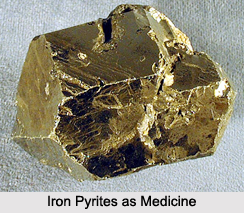 Iron pyrites is met with in many parts of India, and has been used in medicine from a very remote period. It occurs in two forms, namely, in dark yellow nodules with a golden lustre, and in, silvery, radiated crystals. The former is called Svarnamakshika and the latter Taramakshika. The ancients supposed that they contained gold and silver respectively, in combination with other ingredients, and possessed in part the properties of those precious metals.
Iron pyrites is met with in many parts of India, and has been used in medicine from a very remote period. It occurs in two forms, namely, in dark yellow nodules with a golden lustre, and in, silvery, radiated crystals. The former is called Svarnamakshika and the latter Taramakshika. The ancients supposed that they contained gold and silver respectively, in combination with other ingredients, and possessed in part the properties of those precious metals.
Processing of Iron Pyrites
Chemically iron pyrites consists of bisulphide of iron. It is purified by being boiled in lemon juice with one-third of its weight of rock salt in an iron vessel, till the pot turns red hot. It is reduced to powder by being rubbed with oil or goat"s urine and then roasted in a closed crucible. Iron pyrites thus prepared which has a sweetish bitter taste.
Benefits of Iron Pyrites
Iron pyrites is considered as tonic, alterative and useful in anaemia, urinary diseases, ascites, anasarca, prurigo, eye diseases, etc. As an alterative tonic it is generally used in combination with other medicines of its class, such as iron, talc, mercury etc.
Dose of Iron Pyrites in Medicine
The following is an example of Iron Pyrites used in medicine. Take prepared iron, sesamum seeds, long pepper, black pepper and ginger, each 1 part, iron pyrites 5 parts. Beat into a mass with honey. Dose should be about half a drachm in advanced anaemia.
In diseases of the pregnant state, the following called Garbha vinoda rasa is much used, as an alterative tonic. Take iron pyrites and cinnabar, each 4 tolas, ginger, long pepper and black pepper, each 3 tolas, cloves and mace, each 6 tolas, beat them together with water and divide into pills about 4 grains each. One pill should be taken twice daily.
This article is a stub. You can enrich by adding more information to it. Send your Write Up to content@indianetzone.com




















